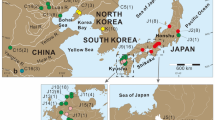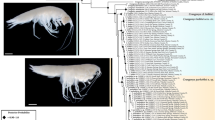Abstract
The freshwater amphipod Crangonyx floridanus (Amphipoda: Crangonyctidae) is considered to have been recently introduced from North America to Japan, and the recorded sites at which it has been collected now cover nearly all of Japan except for the northern part. In this study, we surveyed further areas outside of its known distribution range, and examined the population genetic structure and the phylogenetic relationships between Japanese and North American populations of this species based on nuclear (18S rRNA) and mitochondrial (COI) DNA sequences. We found that this amphipod has already reached Hokkaido, northernmost Japan, which suggests that it has undergone rapid expansion in a pattern of concentric circles from the central part of Japan. Genetic analysis showed that the Japanese population is genetically homogeneous, in contrast to the genetic diversification of this species seen in North American Crangonyx populations. The process of introducing, establishing, and expanding this amphipod in Japan may be explained as follows. A limited number of individuals from a North American native population were probably inadvertently introduced and established somewhere within the Kanto region. The local population size then increased and its distribution range expanded rapidly across Japan.



Similar content being viewed by others
References
Crawford GI (1937) An amphipod, Eucrangonyx gracilis S. I. Smith, new to Britain. Nature 139:327
Englisch U, Koenemann S (2001) Preliminary phylogenetic analysis of selected subterranean amphipod crustacean, using small subunit rDNA sequences. Org Divers Evol 1:139–145
Felsenstein J (1995) Confidence limits on phylogenies: an approach using the bootstrap. Evolution 39:783–791
Folmer O, Black M, Hoeh W, Lutz R, Vrijienchoek R (1994) DNA primers for amplification of mitochondrial cytochrome c oxidase subunit I from diverse metazoan invertebrates. Mol Mar Biol Biotechnol 3:294–299
Hou Z, Fu J, Li S (2007) A molecular phylogeny of the genus Gammarus (Crustacea: Amphipoda) based on mitochondrial and nuclear gene sequences. Mol Phylogenet Evol 45:596–611
Huelsenbeck JP, Ronquist F (2001) MRBAYES: Bayesian inference of phylogenetic trees. Bioinformatics 17:754–755
Hynes HBN (1955) The reproductive cycle of some British freshwater Gammaridae. J Ecol 21:352–387
Kanada S, Kuranishi RB, Ishiwata S, Tojo K, Shimizu T, Taira H, Satake K (2007) Distribution of an alien species, Crangonyx floridanus Bousfield (Crustacea: Amphipoda: Crangonyctidae) in Japan. Jpn J Limnol 68:449–460
Kimura M (1980) A simple method for estimating evolutionary rates of base substitutions through comparative studies of nucleotide sequences. J Mol Evol 16:111–120
Kumar S, Nei M, Dudley J, Tamura K (2008) MEGA: a biologist-centric software for evolutionary analysis of DNA and protein sequences. Brief Bioinform 9:299–306
Morino H, Kusano H, Holsinger JR (2004) Description and distribution of Crangonyx floridanus (Crustacea: Amphipoda: Crangonyctidae) in Japan, an introduced freshwater amphipod from North America. Control Biol Lab Kyoto Univ 29:371–381
Nylander JAA, Ronquist F, Huelsenbeck JP, Nieves-Aldrey JL (2004) Bayesian phylogenetic analysis of combined data. Syst Biol 53:47–67
Saitou N, Nei M (1987) The neighbor-joining method: a new method for reconstructing phylogenetic trees. Mol Biol Evol 4:406–425
Slothouber Galbreath JGM, Smith JE, Becnel JJ, Butlin RK, Dunn AM (2010) Reduction in post-invasion genetic diversity in Crangonyx pseudogracilis (Amphipoda: Crustacea): a genetic bottleneck or the work of hitchhiking vertically transmitted microparasites? Biol Invasion 12:191–209
Tamura K, Dudley J, Nei M, Kumar S (2007) MEGA 4: molecular evolutionary genetics analysis (MEGA) software version 4.0. Mol Biol Evol 24:1596–1599
Tanaka Y, Tanizawa T, Suzuki K, Sekiné K, Tojo K (2007) Distribution of the introduced freshwater amphipod Crangonyx floridanus in the Matsumoto basin (Crustacea: Amphipoda, Crangonyctidae). Bull Shiojiri City Mus Nat Hist 9:40–45
Tanaka Y, Nagakubo A, Tojo K (2010) Population dynamics of the introduced crangonyctid amphipod Crangonyx floridanus and native anisogammarid Jesogammarus jesoensis at the Tategawa River in Azumino City, Nagano Prefecture. Jpn J Limnol (in press)
Thompson JD, Higgins DG, Gibson TJ (1994) Clustal W: improving the sensitivity of progressive multiple sequence alignment through sequence weighting, position-specific gap penalties and weight matrix choice. Nucleic Acid Res 22:4673–4680
Toft JD, Cordell JR, Fields WC (2002) New records of crustaceans (Amphipoda, Isopoda) in the Sacramento/San Joaquin Delta, California, and application of criteria for introduced species. J Crustac Biol 22:190–200
Toft JD, Simenstad CA, Cordell JR, Grimaldo LF (2003) The effects of introduced water hyacinth on habitat structure, invertebrate assemblages, and fish diets. Estuaries 26:746–758
Tojo K, Tanizawa T, Sekiné K, Suzuki K, Miyairi K, Tanaka Y (2007) Distribution of the introduced freshwater amphipod Crangonyx floridanus in the Chikuma River (Crustecea: Amphipoda, Crangonyctidae). Bull Shiojiri City Mus Nat Hist 9:35–39
Tojo K, Tanaka Y, Kuranishi RB, Kanada S (2010) Reproductive biology and adaptability of the invasive alien freshwater amphipod Crangonyx floridanus (Crustacea: Amphipoda, Crangonyctidae). Zool Sci. doi:10.2108/zsj.27.000
Zhang J (1997) Systematics of the freshwater amphipod genus Crangonyx (Crangonyctidae) in North America (dissertation). Old Dominion University, Norfolk, VA
Zhang J, Holsinger JR (2003) Systematics of the freshwater amphipod genus Crangonyx (Crangonyctidae) in North America. Virginia Mus Nat Hist Mem 6(1–274):183–199
Acknowledgments
We acknowledge the valuable suggestions and support of Drs. T. Ito (Eniwa, Hokkaido), H. Kusano (Tama, Kawasaki), S. Ishiwata (Kanagawa Environmental Research Center), T. Tsutsumi (Fukushima University), T. Yoshida (NPO Research Office of Sustainable Riversystems for Natural Cultural Features), K. Miyazaki (Kyoto University) and K. Satake (National Institute for Environmental Studies). We are also indebted to Mr/s. T. Tanizawa, K. Suzuki, K. Miyairi, K. Oka, M. Sueyoshi, T. Kano and M. Mochizuki, Y. Morii (Shinshu University) for their cooperation in the field research. This study was supported by grants from the River Fund (Foundation of River & Watershed Environment) to K.T. and the Research Institute of Marine Invertebrates to K.T.
Author information
Authors and Affiliations
Corresponding author
Rights and permissions
About this article
Cite this article
Nagakubo, A., Sekiné, K., Tanaka, Y. et al. Rapid expansion of the distributional range and the population genetic structure of the freshwater amphipod Crangonyx floridanus in Japan. Limnology 12, 75–82 (2011). https://doi.org/10.1007/s10201-010-0323-3
Received:
Accepted:
Published:
Issue Date:
DOI: https://doi.org/10.1007/s10201-010-0323-3




